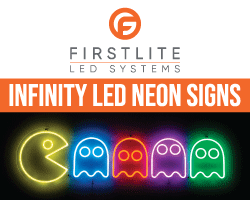New IPIA print industry research helps print companies navigate new markets and find routes to growth

At its recent Annual Conference, the IPIA launched a major new initiative based on extensive print industry research and analysis.
Between them, Brendan Perring, General Manager of the IPIA, and Carey Trevill, Director and Co-founder of Mission Element, unveiled the IPIA’s ground-breaking research and advocacy project for the UK print industry. The core objective of this project is to shift the perception of print among UK consumers and businesses across a range of critical factors.
The initiative has been made possible by a coalition of IPIA Members that are working in partnership to ensure it delivers on its objectives: Imprint MIS, Ricoh, Konica Minolta, Epson, The Printing Charity and Citipost.

Brendan told the audience of IPIA members and partners that way back in 2020, Alasdair Browne, the Vice-Chair of the IPIA’s Research Subcommittee, walked into a council meeting and turned everything on its head. He introduced the research company Madano, which brought with it the modern concepts of data science and analytics and the fast-developing world of AI and machine learning. He also showed what Madano has been able to do to help industries all over the world by exposing misperceptions and shifting peoples’ opinions and understanding.
He used the salmon farming industry as an example, which had suffered from a negative perception due to several hyperbolic mainstream media headlines. This affected the whole industry because retailers were dropping the product, putting consumers off. Madano worked with the industry’s trade association to identify where this negative influence was coming from and found that it was one voice amongst many, but that one voice was the only one people could hear.
By gathering information from a wider source, Madano found that the industry was doing all sorts of things to protect wild salmon and rivers, but this was not being reported. By putting this new narrative into the market, they restored retailer confidence, and the industry enjoyed endorsements from the World Wildlife Fund and the United Nations.
Turning a negative narrative into a positive one is no easy task. However, the IPIA has decided to do just that, which was announced at the conference.

Studying more than 12,000 online conversations across social media, media outlets, blogs and forums – the study has also identified key influencers who significantly sway the perception of the print industry and its products. Madano also analysed the dominant narratives in the conversation around print.
By obtaining an accurate picture of how the print industry and its products are perceived – and by identifying the individuals and organisations driving these perceptions – the IPIA and its partners can develop a long-term strategy to strengthen the print market in the UK. Ultimately, by increasing the positive perception of print’s effectiveness, sustainability and positive contribution to society, the result will be an uplift in both businesses and consumers utilising print as a marketing and communications medium.

Alasdair emphasised the importance of this research in shaping the future of the print industry, “This project is a crucial step in understanding the dynamics of our industry. By identifying the key influencers and the narratives they are driving, we can also better position ourselves as an industry to respond to challenges and seize opportunities. The insights from this research will be instrumental in guiding our strategies and ensuring the continued relevance and growth of print.”
In his introduction, Brendan talked about the complacency towards marketing that had led the print industry into a difficult position. He noted that the print industry hadn’t had much competition for hundreds of years. “When the digital industry appeared, it came with a huge explosion of publicity, mainly across the media it had created. It was new, nimble, and exciting, and marketing was an integral part of its DNA.”
He continued, “It wasn’t the same for print. We have had to play catch-up over the last 20 years and have reached a point where we don’t know our place in this new landscape. We make a lot of marketing noise as individual companies and as an industry, but is this getting out of our bubble and into the consciousness of a wider audience? We commissioned this research to better understand what is happening out there in the global market and what people actually think of our industry.”
The Research
To help develop this vital new strategy, IPIA commissioned Madano to analyse hundreds of thousands of pieces of online data and content sourced from the UK. They then boiled this down to 12,141 pieces of content and online conversations that met the IPIA’s strict search criteria and that they felt were valuable and worthy of further investigation.

They then categorised and organised the data into graphics and charts so they could analyse it effectively and develop a plan of action.
“The research has shown that the printing industry is losing the narrative battle,” said Brendan. “Individually, we are winning business with major brands or smaller businesses where we have direct communication or relationships. But the broader industry trend shows that conversation by conversation, we are losing the war, and this needs to be addressed if our industry is to succeed and grow again.”

The project’s development is being supported by Carey Trevill, founder of Mission Element, a consultancy working across the marketing and advertising industry, supporting a range of businesses, including trade associations. She is also a director of the consultancy, theSPC, which interrogates production spend, conducts print tenders and reviews operational efficacy for a range of global brand owners.
With a deep understanding of the effectiveness and potential of print as a marketing medium, especially when it is used within multi-channel campaigns, Carey has had an extensive and highly successful career in the marketing industry and has headed up award-winning campaigns for global brands.
She explained at the conference, “What we can see in this research is a lot of inertia, and that isn’t good for the industry. We need to find out the root causes of these conversations because while many people talk about the value of print, we need to get to the emotion behind these statements to find out what makes print happen.”
She added, “Looking at this research in forensic detail, we believe there is an incredible opportunity here. We can be very positive about the future and the possibilities of print and educate those who should be interacting with it. But – we have a long way to go.”
Restoring confidence
Carey said that the IPIA’s investment in this research will greatly help restore confidence in the print industry, which will benefit its members. “Print companies often speak in defence of print because that has become our traditional position. These same companies are driving and developing incredible innovations, but these achievements are not getting out of the echo chamber that we are in. Our competitors may not have a solution as good as ours, but they can shout a lot louder, and we are not being heard. We need to get our message out to the right people, and this means thinking about our overall narrative.”
This research has provided the industry and IPIA members with some hugely important information that it can use to fight back. It provides data that shows what influences and motivates the mainstream decisions to use or not use print. What is its effectiveness as a marketing tool in comparison to other techniques? What is the real view of sustainability—not just the lazy headline view? These questions and many more form the backbone of the work that the IPIA is doing to help bring growth back to the printing industry.
A targeted approach
The study’s findings have now equipped the IPIA and its partners with the knowledge needed to develop a series of positives narratives that tell the story of print’s effectiveness, sustainability and beneficial impact on culture, society and the arts.
Key print industry research findings
Following release of Madano’s study, a first step has been to assess how the industry positions itself. “The research has identified what is driving the narrative now is a defensive position, not one of promotion – as much as the print industry has engineered it to be positive,” said Carey.
Examining how the industry is currently presenting, she explained that the research identified some key themes in this regard:
- As an industry, it often speaks in defence of print – defending its traditional position against other media
- The industry drives and develops incredible innovation, and findings show we are ‘talking to ourselves’ about what’s possible and not breaking through to the right audiences
- The industry is desperate to show print is better than digital advertising or other forms of communication, rather than how it might work to enhance the effectiveness of those mediums
- Print can struggle to cut through and demonstrate why print is effective to those who should see our medium as a viable and engaging route to market
- Print needs and wants to show how sustainable a medium this is, but come up against significant, louder reasons of why this is a challenging idea or concept- even when we have better proof than other routes to market
Carey commented on these finding, “We could shrug our shoulders and say ‘it’s just how it is’ – or we can get to the very root cause of what is really driving the conversation with our customers and consumers and instigate a shift change.
To extend the thinking, a range of critical questions were devised to examine print – drawing conversations from broad communities; marketing, advertising, design, photography and fashion/textiles.

Questions included:
- What is the level of conversation and general awareness of print out in our target print buying markets and amongst consumers?
- What is the perception of print’s effectiveness when used within a multi-channel marketing campaign?
- What is really influencing and motivating business to choose – or not – print when they consider their marketing methods?
- What is the view of digital and mainstream media’s effectiveness as a marketing and communications medium?
- What is the level of awareness about the career opportunities within the sector and its status as an advanced technology-driven industry?
- What is the true perception of print’s sustainability, measurability and its ROI?
- What is the status of trust when it comes to printed media vs digital?
Trevill continued, “The good news is that the research is complete, and we’ve got the answers to the questions we raised. It told us many times over what print made happen – print made this experience, this emotion, this presence, this impact. It also showed us why print wasn’t considered as viable option, often in comparison with other media in relation to cost, complexity, ROI.”

The positive themes that came through from the mapping of thousands of online conversations around print, focussed on where potential and possibilities can be captured in a unique way. This is not news to the print industry – but to its influencing stakeholders, print is central to how they view ways to communicate and connect in conjunction with other media:
Brendan concluded, “Knowledge is power. With a true, accurate, no-holds-barred understanding of the market and its perception, we can help print companies develop strategies to build new markets and increase revenue and profitability.”
For more information on this initiative, please contact the IPIA on brendan@ipia.org.uk
Read more about the IPIA on Eye on Display.

















